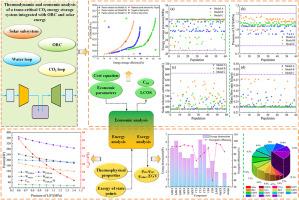Thermodynamic and economic analysis of a trans-critical CO2 energy storage system integrated with ORC and solar energy
IF 9
1区 工程技术
Q1 ENERGY & FUELS
引用次数: 0
Abstract
In this paper, a CO2 energy storage system that integrates an organic Rankine cycle (ORC) with solar energy is proposed to support grid peaking, enhance the efficient use of renewable energy sources, and optimize system performance. A thermodynamic analysis of the system has been performed and the performance under different operating models is evaluated. In model A, the energy storage efficiency of the system is 77.28 %, the solar energy conversion efficiency is 30.7 %, and the exergy efficiency is 66.1 %. In models B and C, the energy storage efficiency is 76.72 % and 80 %, the solar conversion efficiency is 32.2 % and 31.5 %, and the exergy efficiency is 66.8 % and 65.2 %, respectively. To evaluate the thermodynamic and economic performance of the system, the effect of the decision variables on the system performance is analyzed. Then, the NSGA-II optimization algorithm was applied to optimize the system, and the TOPSIS method was used to evaluate the optimization results. The results show that the energy storage efficiencies under optimal operating conditions are 78.8 %, 77.5 %, and 81.1 % for operating models A, B, and C, respectively. In addition, the levelized cost of storage (LCOS) for operating models A, B, and C are 0.307$/(kW∙h), 0.316$/(kW∙h), and 0.318$/(kW∙h), respectively.

集成 ORC 和太阳能的跨临界二氧化碳储能系统的热力学和经济分析
本文提出了一种将有机郎肯循环(ORC)与太阳能集成在一起的二氧化碳储能系统,以支持电网调峰,提高可再生能源的使用效率,并优化系统性能。对该系统进行了热力学分析,并评估了其在不同运行模式下的性能。在模式 A 中,系统的储能效率为 77.28%,太阳能转换效率为 30.7%,放能效率为 66.1%。在模型 B 和 C 中,储能效率分别为 76.72 % 和 80 %,太阳能转换效率分别为 32.2 % 和 31.5 %,放能效率分别为 66.8 % 和 65.2 %。为了评估系统的热力学和经济性能,分析了决策变量对系统性能的影响。然后,应用 NSGA-II 优化算法对系统进行优化,并采用 TOPSIS 方法对优化结果进行评估。结果表明,在最佳运行条件下,运行模式 A、B 和 C 的储能效率分别为 78.8%、77.5% 和 81.1%。此外,运行模式 A、B 和 C 的平准化储能成本(LCOS)分别为 0.307 美元/(kW∙h)、0.316 美元/(kW∙h)和 0.318 美元/(kW∙h)。
本文章由计算机程序翻译,如有差异,请以英文原文为准。
求助全文
约1分钟内获得全文
求助全文
来源期刊

Energy
工程技术-能源与燃料
CiteScore
15.30
自引率
14.40%
发文量
0
审稿时长
14.2 weeks
期刊介绍:
Energy is a multidisciplinary, international journal that publishes research and analysis in the field of energy engineering. Our aim is to become a leading peer-reviewed platform and a trusted source of information for energy-related topics.
The journal covers a range of areas including mechanical engineering, thermal sciences, and energy analysis. We are particularly interested in research on energy modelling, prediction, integrated energy systems, planning, and management.
Additionally, we welcome papers on energy conservation, efficiency, biomass and bioenergy, renewable energy, electricity supply and demand, energy storage, buildings, and economic and policy issues. These topics should align with our broader multidisciplinary focus.
 求助内容:
求助内容: 应助结果提醒方式:
应助结果提醒方式:


